Analysis of Unilever's Dove Brand: International Supply Chain
VerifiedAdded on 2023/05/29
|20
|3976
|413
Report
AI Summary
This report undertakes a comprehensive analysis of Unilever's Dove brand, focusing on its international business and supply chain strategies. It begins by examining Unilever's international business strategy, specifically how Dove fits within it, transitioning from an international strategy to a multi-domestic approach. The report then delves into Dove's global supply chain strategy, evaluating its strategic fit with the international strategy, and highlighting the cost versus responsiveness trade-offs. A detailed examination of the five key elements of the global supply chain – facilities, sourcing/procurement, inventory, transportation/distribution, and information sharing – is provided, along with an analysis of how these elements are interconnected. The analysis identifies gaps in the distribution network. Finally, the report concludes with specific recommendations for improving Dove's global supply chain, directly addressing the identified gaps and aiming to enhance efficiency and responsiveness. The report uses the Harvard referencing style.
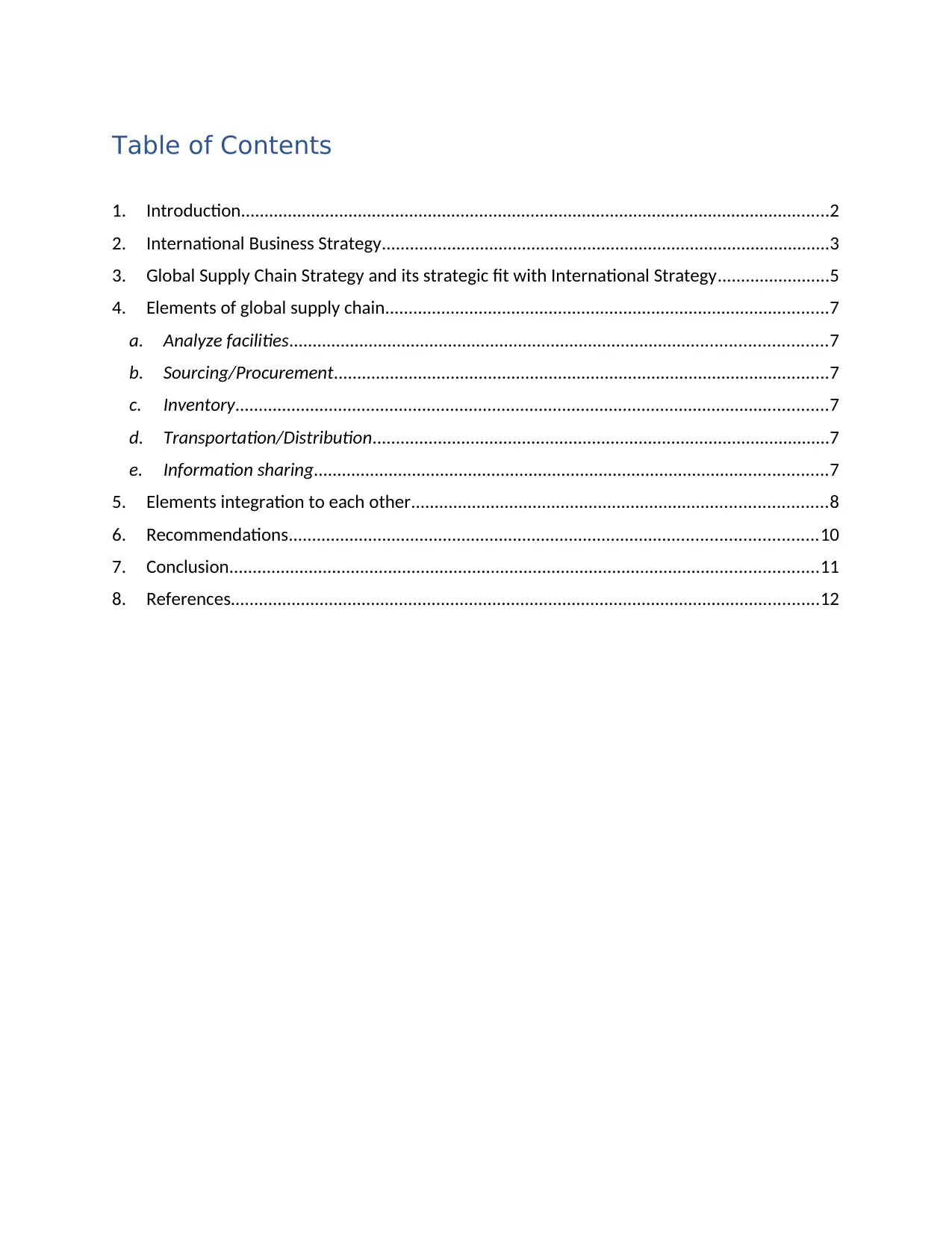
Table of Contents
1. Introduction..............................................................................................................................2
2. International Business Strategy................................................................................................3
3. Global Supply Chain Strategy and its strategic fit with International Strategy........................5
4. Elements of global supply chain...............................................................................................7
a. Analyze facilities...................................................................................................................7
b. Sourcing/Procurement..........................................................................................................7
c. Inventory...............................................................................................................................7
d. Transportation/Distribution..................................................................................................7
e. Information sharing..............................................................................................................7
5. Elements integration to each other.........................................................................................8
6. Recommendations.................................................................................................................10
7. Conclusion..............................................................................................................................11
8. References..............................................................................................................................12
1. Introduction..............................................................................................................................2
2. International Business Strategy................................................................................................3
3. Global Supply Chain Strategy and its strategic fit with International Strategy........................5
4. Elements of global supply chain...............................................................................................7
a. Analyze facilities...................................................................................................................7
b. Sourcing/Procurement..........................................................................................................7
c. Inventory...............................................................................................................................7
d. Transportation/Distribution..................................................................................................7
e. Information sharing..............................................................................................................7
5. Elements integration to each other.........................................................................................8
6. Recommendations.................................................................................................................10
7. Conclusion..............................................................................................................................11
8. References..............................................................................................................................12
Paraphrase This Document
Need a fresh take? Get an instant paraphrase of this document with our AI Paraphraser
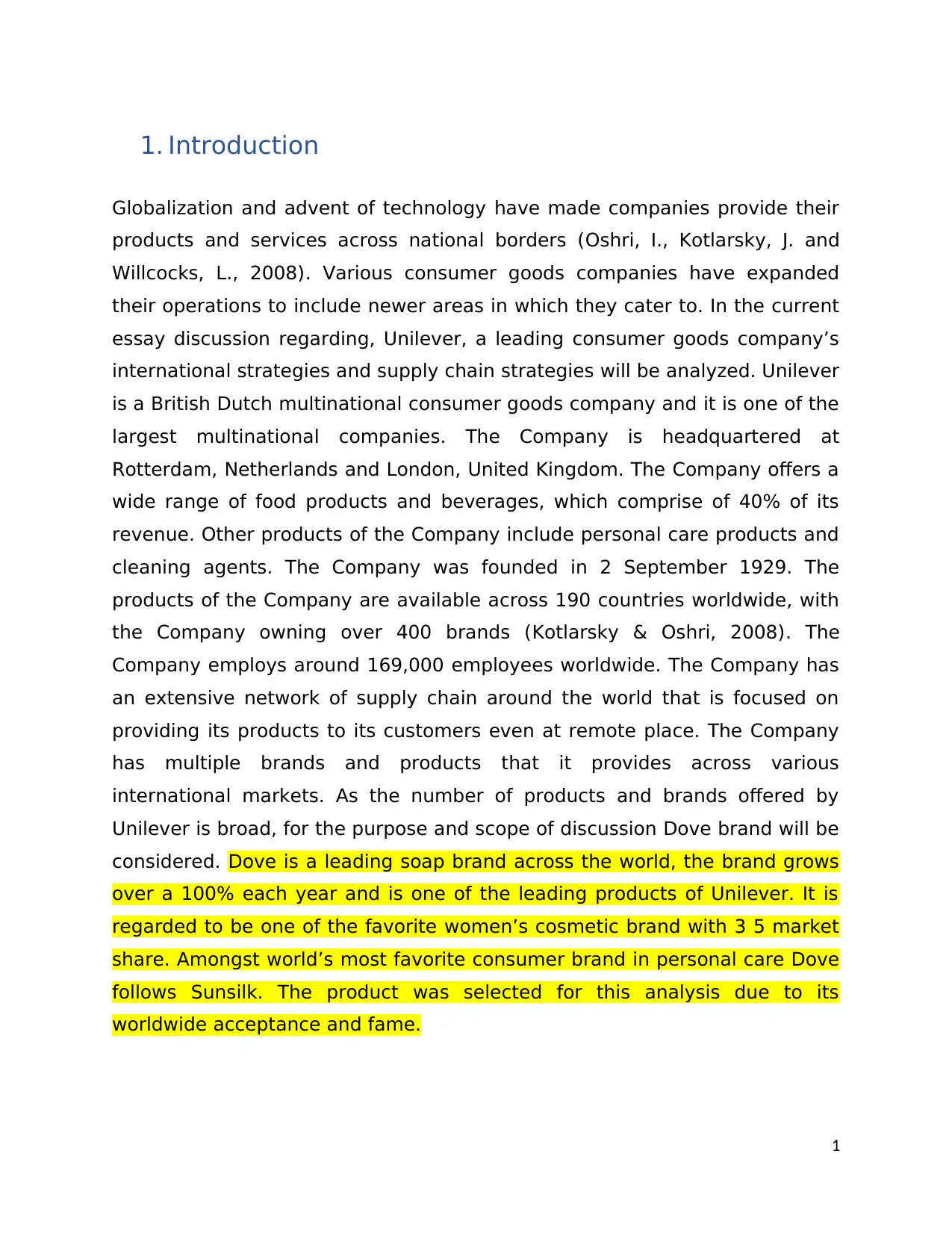
1. Introduction
Globalization and advent of technology have made companies provide their
products and services across national borders (Oshri, I., Kotlarsky, J. and
Willcocks, L., 2008). Various consumer goods companies have expanded
their operations to include newer areas in which they cater to. In the current
essay discussion regarding, Unilever, a leading consumer goods company’s
international strategies and supply chain strategies will be analyzed. Unilever
is a British Dutch multinational consumer goods company and it is one of the
largest multinational companies. The Company is headquartered at
Rotterdam, Netherlands and London, United Kingdom. The Company offers a
wide range of food products and beverages, which comprise of 40% of its
revenue. Other products of the Company include personal care products and
cleaning agents. The Company was founded in 2 September 1929. The
products of the Company are available across 190 countries worldwide, with
the Company owning over 400 brands (Kotlarsky & Oshri, 2008). The
Company employs around 169,000 employees worldwide. The Company has
an extensive network of supply chain around the world that is focused on
providing its products to its customers even at remote place. The Company
has multiple brands and products that it provides across various
international markets. As the number of products and brands offered by
Unilever is broad, for the purpose and scope of discussion Dove brand will be
considered. Dove is a leading soap brand across the world, the brand grows
over a 100% each year and is one of the leading products of Unilever. It is
regarded to be one of the favorite women’s cosmetic brand with 3 5 market
share. Amongst world’s most favorite consumer brand in personal care Dove
follows Sunsilk. The product was selected for this analysis due to its
worldwide acceptance and fame.
1
Globalization and advent of technology have made companies provide their
products and services across national borders (Oshri, I., Kotlarsky, J. and
Willcocks, L., 2008). Various consumer goods companies have expanded
their operations to include newer areas in which they cater to. In the current
essay discussion regarding, Unilever, a leading consumer goods company’s
international strategies and supply chain strategies will be analyzed. Unilever
is a British Dutch multinational consumer goods company and it is one of the
largest multinational companies. The Company is headquartered at
Rotterdam, Netherlands and London, United Kingdom. The Company offers a
wide range of food products and beverages, which comprise of 40% of its
revenue. Other products of the Company include personal care products and
cleaning agents. The Company was founded in 2 September 1929. The
products of the Company are available across 190 countries worldwide, with
the Company owning over 400 brands (Kotlarsky & Oshri, 2008). The
Company employs around 169,000 employees worldwide. The Company has
an extensive network of supply chain around the world that is focused on
providing its products to its customers even at remote place. The Company
has multiple brands and products that it provides across various
international markets. As the number of products and brands offered by
Unilever is broad, for the purpose and scope of discussion Dove brand will be
considered. Dove is a leading soap brand across the world, the brand grows
over a 100% each year and is one of the leading products of Unilever. It is
regarded to be one of the favorite women’s cosmetic brand with 3 5 market
share. Amongst world’s most favorite consumer brand in personal care Dove
follows Sunsilk. The product was selected for this analysis due to its
worldwide acceptance and fame.
1

Figure 1: World's Leading Consumer Brands
Source: Statistica
The Company’s expanding global supply chain network allows the Company
to be recognized to be as one of the most profitable company’s in consumer
goods (Ellram, Tate & Billington, 2008). Its integrated network of supply
chain provides the Company its key values. The aim of the current report is
hence; To analyze the international supply chain network of Unilever’s Dove
brand. In order to attend to the aim, the following objectives will need to be
attended.
Objective 1: To analyze the international strategy of Unilever’s Dove Objective 2: To understand the global supply chain and its fit with
international strategy of Dove Objective 3: To analyze the various elements of global supply chain of
Dove Objective 4: To provide recommendations for bridging gap in global
supply chain of Dove
2
Source: Statistica
The Company’s expanding global supply chain network allows the Company
to be recognized to be as one of the most profitable company’s in consumer
goods (Ellram, Tate & Billington, 2008). Its integrated network of supply
chain provides the Company its key values. The aim of the current report is
hence; To analyze the international supply chain network of Unilever’s Dove
brand. In order to attend to the aim, the following objectives will need to be
attended.
Objective 1: To analyze the international strategy of Unilever’s Dove Objective 2: To understand the global supply chain and its fit with
international strategy of Dove Objective 3: To analyze the various elements of global supply chain of
Dove Objective 4: To provide recommendations for bridging gap in global
supply chain of Dove
2
⊘ This is a preview!⊘
Do you want full access?
Subscribe today to unlock all pages.

Trusted by 1+ million students worldwide
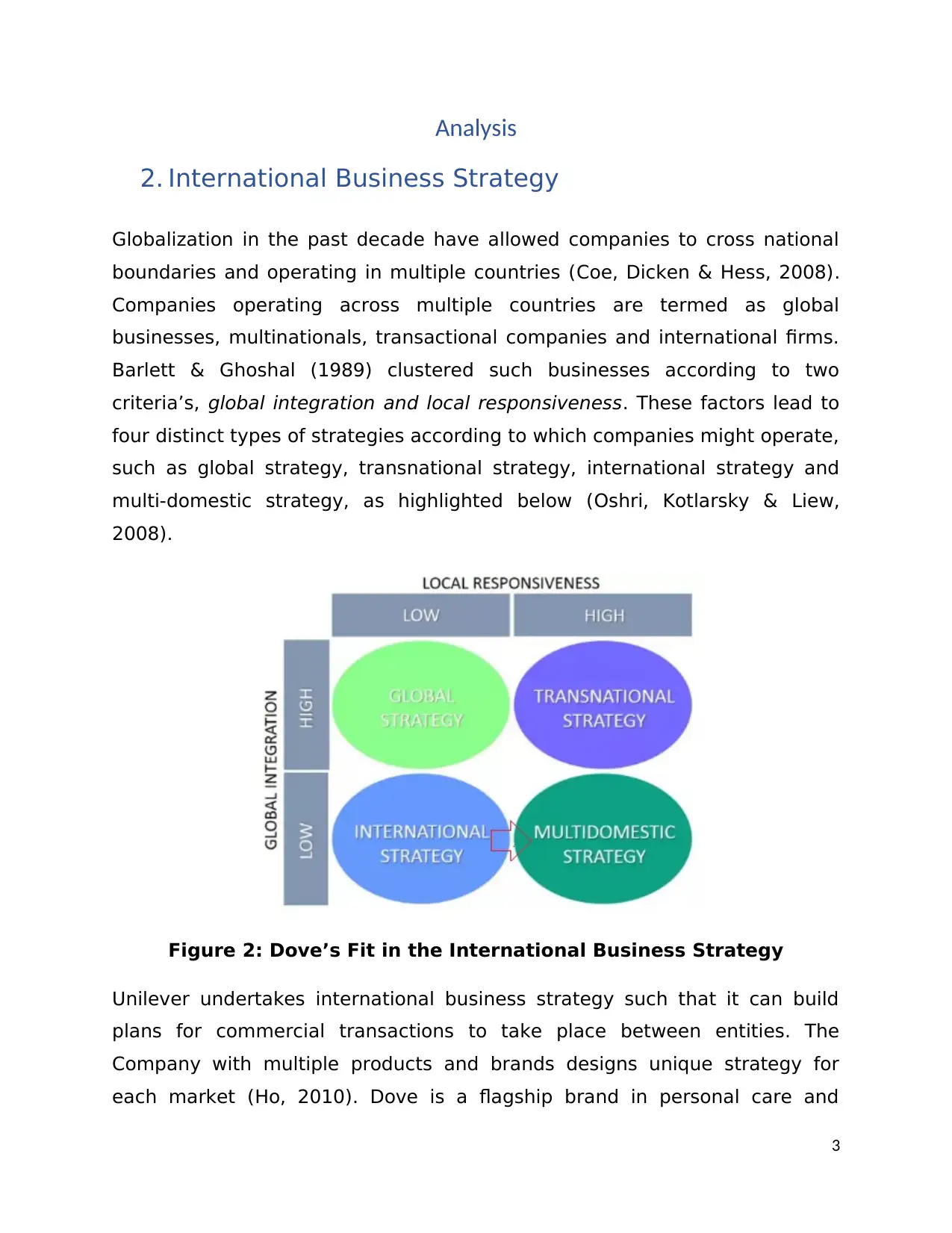
Analysis
2. International Business Strategy
Globalization in the past decade have allowed companies to cross national
boundaries and operating in multiple countries (Coe, Dicken & Hess, 2008).
Companies operating across multiple countries are termed as global
businesses, multinationals, transactional companies and international firms.
Barlett & Ghoshal (1989) clustered such businesses according to two
criteria’s, global integration and local responsiveness. These factors lead to
four distinct types of strategies according to which companies might operate,
such as global strategy, transnational strategy, international strategy and
multi-domestic strategy, as highlighted below (Oshri, Kotlarsky & Liew,
2008).
Figure 2: Dove’s Fit in the International Business Strategy
Unilever undertakes international business strategy such that it can build
plans for commercial transactions to take place between entities. The
Company with multiple products and brands designs unique strategy for
each market (Ho, 2010). Dove is a flagship brand in personal care and
3
2. International Business Strategy
Globalization in the past decade have allowed companies to cross national
boundaries and operating in multiple countries (Coe, Dicken & Hess, 2008).
Companies operating across multiple countries are termed as global
businesses, multinationals, transactional companies and international firms.
Barlett & Ghoshal (1989) clustered such businesses according to two
criteria’s, global integration and local responsiveness. These factors lead to
four distinct types of strategies according to which companies might operate,
such as global strategy, transnational strategy, international strategy and
multi-domestic strategy, as highlighted below (Oshri, Kotlarsky & Liew,
2008).
Figure 2: Dove’s Fit in the International Business Strategy
Unilever undertakes international business strategy such that it can build
plans for commercial transactions to take place between entities. The
Company with multiple products and brands designs unique strategy for
each market (Ho, 2010). Dove is a flagship brand in personal care and
3
Paraphrase This Document
Need a fresh take? Get an instant paraphrase of this document with our AI Paraphraser
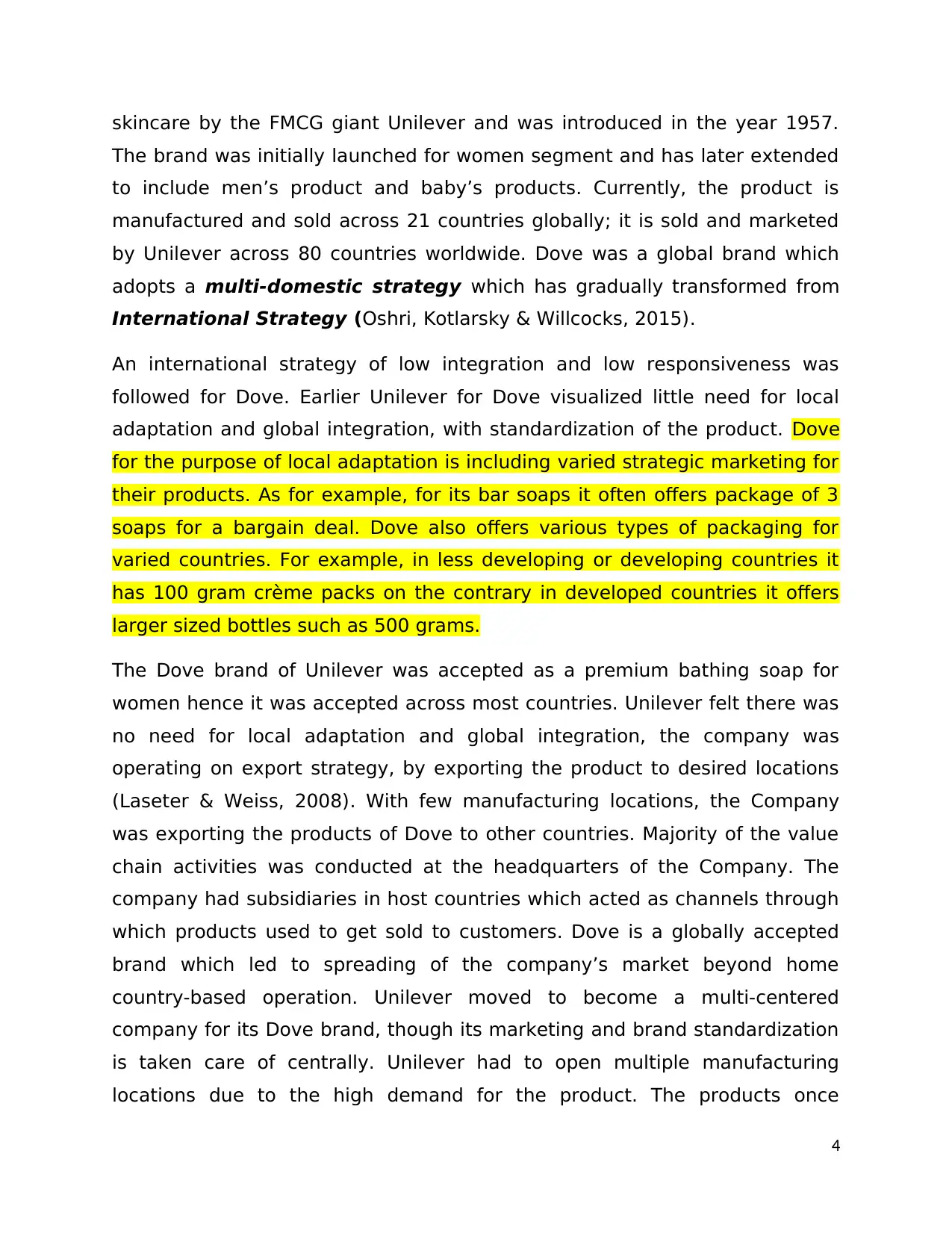
skincare by the FMCG giant Unilever and was introduced in the year 1957.
The brand was initially launched for women segment and has later extended
to include men’s product and baby’s products. Currently, the product is
manufactured and sold across 21 countries globally; it is sold and marketed
by Unilever across 80 countries worldwide. Dove was a global brand which
adopts a multi-domestic strategy which has gradually transformed from
International Strategy (Oshri, Kotlarsky & Willcocks, 2015).
An international strategy of low integration and low responsiveness was
followed for Dove. Earlier Unilever for Dove visualized little need for local
adaptation and global integration, with standardization of the product. Dove
for the purpose of local adaptation is including varied strategic marketing for
their products. As for example, for its bar soaps it often offers package of 3
soaps for a bargain deal. Dove also offers various types of packaging for
varied countries. For example, in less developing or developing countries it
has 100 gram crème packs on the contrary in developed countries it offers
larger sized bottles such as 500 grams.
The Dove brand of Unilever was accepted as a premium bathing soap for
women hence it was accepted across most countries. Unilever felt there was
no need for local adaptation and global integration, the company was
operating on export strategy, by exporting the product to desired locations
(Laseter & Weiss, 2008). With few manufacturing locations, the Company
was exporting the products of Dove to other countries. Majority of the value
chain activities was conducted at the headquarters of the Company. The
company had subsidiaries in host countries which acted as channels through
which products used to get sold to customers. Dove is a globally accepted
brand which led to spreading of the company’s market beyond home
country-based operation. Unilever moved to become a multi-centered
company for its Dove brand, though its marketing and brand standardization
is taken care of centrally. Unilever had to open multiple manufacturing
locations due to the high demand for the product. The products once
4
The brand was initially launched for women segment and has later extended
to include men’s product and baby’s products. Currently, the product is
manufactured and sold across 21 countries globally; it is sold and marketed
by Unilever across 80 countries worldwide. Dove was a global brand which
adopts a multi-domestic strategy which has gradually transformed from
International Strategy (Oshri, Kotlarsky & Willcocks, 2015).
An international strategy of low integration and low responsiveness was
followed for Dove. Earlier Unilever for Dove visualized little need for local
adaptation and global integration, with standardization of the product. Dove
for the purpose of local adaptation is including varied strategic marketing for
their products. As for example, for its bar soaps it often offers package of 3
soaps for a bargain deal. Dove also offers various types of packaging for
varied countries. For example, in less developing or developing countries it
has 100 gram crème packs on the contrary in developed countries it offers
larger sized bottles such as 500 grams.
The Dove brand of Unilever was accepted as a premium bathing soap for
women hence it was accepted across most countries. Unilever felt there was
no need for local adaptation and global integration, the company was
operating on export strategy, by exporting the product to desired locations
(Laseter & Weiss, 2008). With few manufacturing locations, the Company
was exporting the products of Dove to other countries. Majority of the value
chain activities was conducted at the headquarters of the Company. The
company had subsidiaries in host countries which acted as channels through
which products used to get sold to customers. Dove is a globally accepted
brand which led to spreading of the company’s market beyond home
country-based operation. Unilever moved to become a multi-centered
company for its Dove brand, though its marketing and brand standardization
is taken care of centrally. Unilever had to open multiple manufacturing
locations due to the high demand for the product. The products once
4
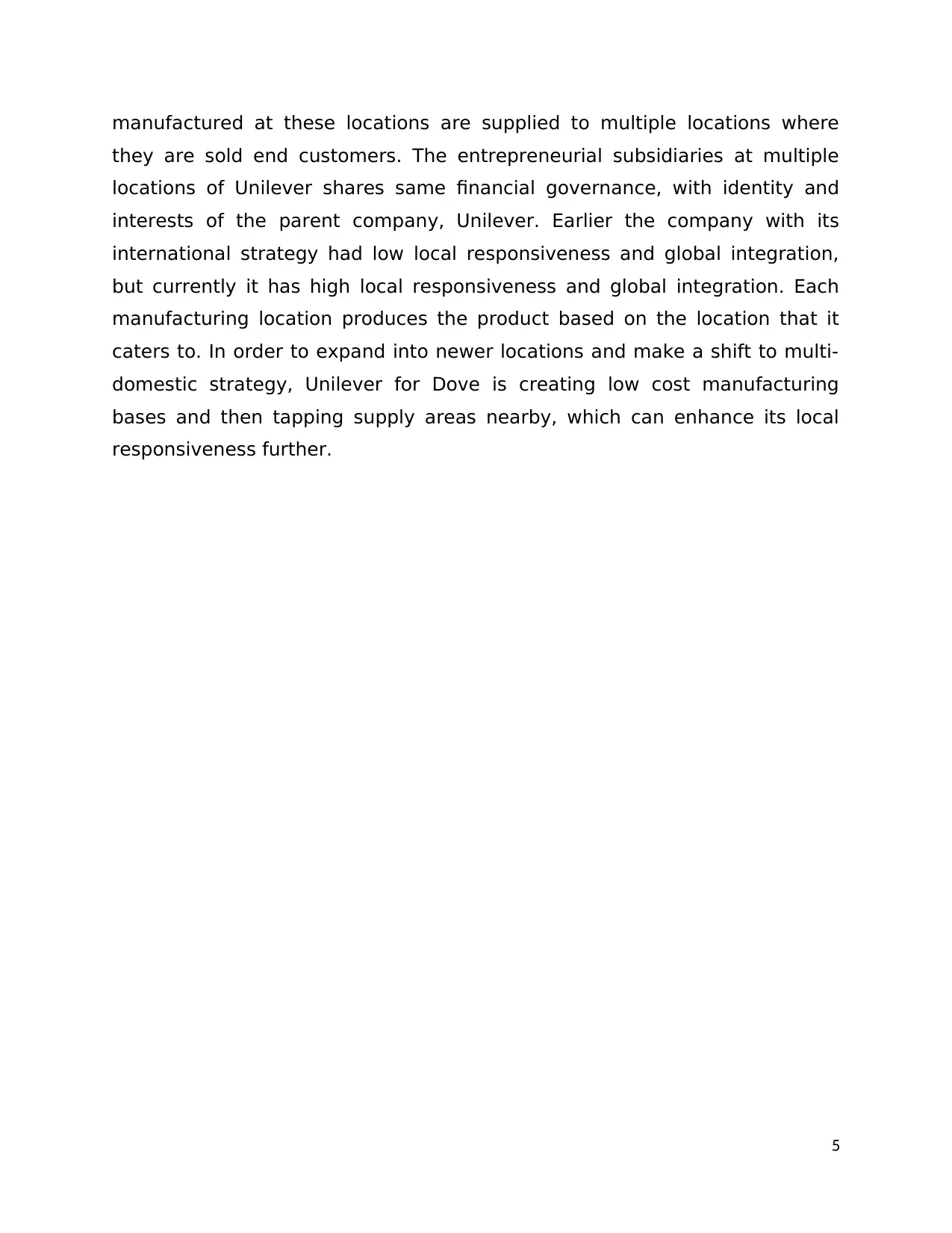
manufactured at these locations are supplied to multiple locations where
they are sold end customers. The entrepreneurial subsidiaries at multiple
locations of Unilever shares same financial governance, with identity and
interests of the parent company, Unilever. Earlier the company with its
international strategy had low local responsiveness and global integration,
but currently it has high local responsiveness and global integration. Each
manufacturing location produces the product based on the location that it
caters to. In order to expand into newer locations and make a shift to multi-
domestic strategy, Unilever for Dove is creating low cost manufacturing
bases and then tapping supply areas nearby, which can enhance its local
responsiveness further.
5
they are sold end customers. The entrepreneurial subsidiaries at multiple
locations of Unilever shares same financial governance, with identity and
interests of the parent company, Unilever. Earlier the company with its
international strategy had low local responsiveness and global integration,
but currently it has high local responsiveness and global integration. Each
manufacturing location produces the product based on the location that it
caters to. In order to expand into newer locations and make a shift to multi-
domestic strategy, Unilever for Dove is creating low cost manufacturing
bases and then tapping supply areas nearby, which can enhance its local
responsiveness further.
5
⊘ This is a preview!⊘
Do you want full access?
Subscribe today to unlock all pages.

Trusted by 1+ million students worldwide
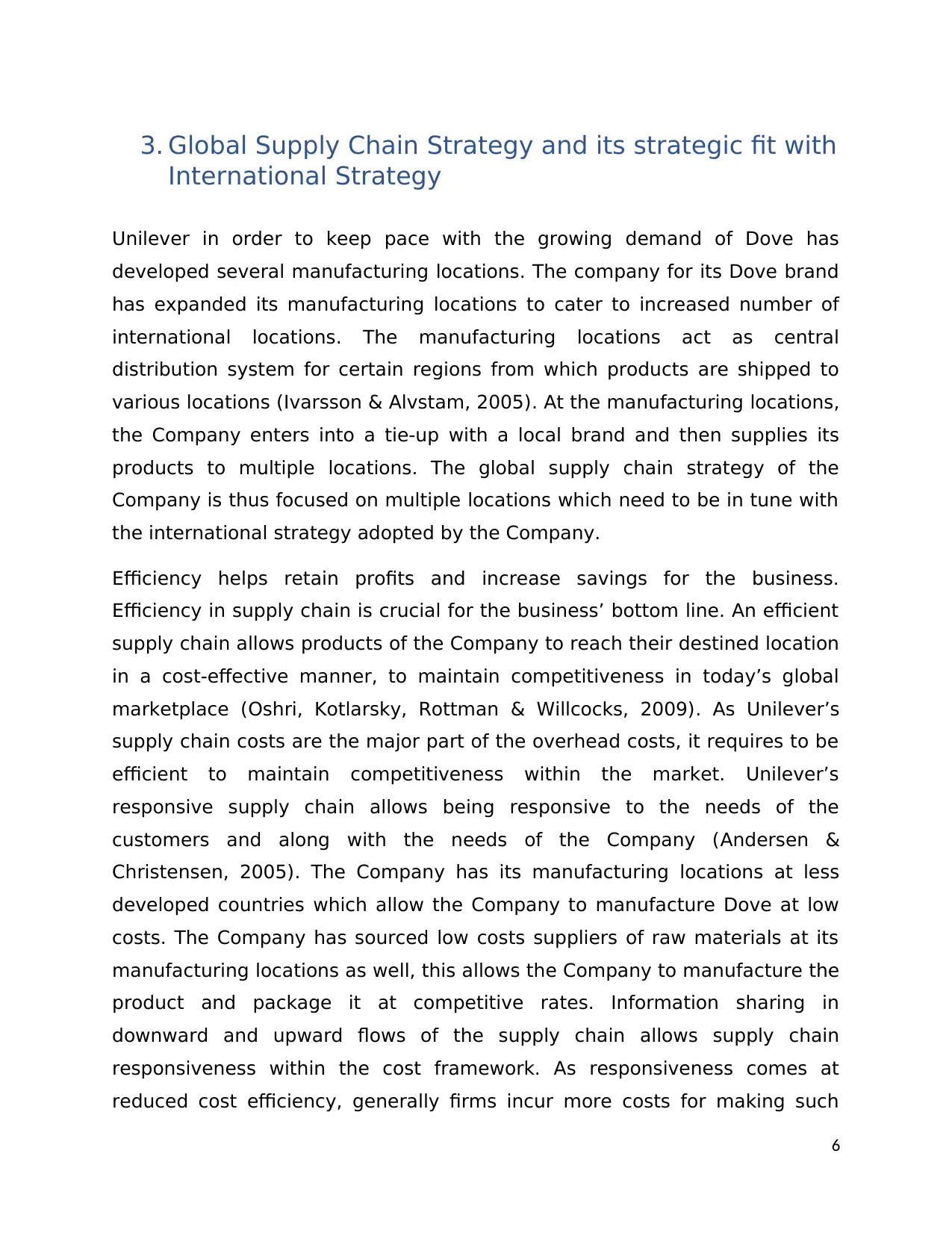
3. Global Supply Chain Strategy and its strategic fit with
International Strategy
Unilever in order to keep pace with the growing demand of Dove has
developed several manufacturing locations. The company for its Dove brand
has expanded its manufacturing locations to cater to increased number of
international locations. The manufacturing locations act as central
distribution system for certain regions from which products are shipped to
various locations (Ivarsson & Alvstam, 2005). At the manufacturing locations,
the Company enters into a tie-up with a local brand and then supplies its
products to multiple locations. The global supply chain strategy of the
Company is thus focused on multiple locations which need to be in tune with
the international strategy adopted by the Company.
Efficiency helps retain profits and increase savings for the business.
Efficiency in supply chain is crucial for the business’ bottom line. An efficient
supply chain allows products of the Company to reach their destined location
in a cost-effective manner, to maintain competitiveness in today’s global
marketplace (Oshri, Kotlarsky, Rottman & Willcocks, 2009). As Unilever’s
supply chain costs are the major part of the overhead costs, it requires to be
efficient to maintain competitiveness within the market. Unilever’s
responsive supply chain allows being responsive to the needs of the
customers and along with the needs of the Company (Andersen &
Christensen, 2005). The Company has its manufacturing locations at less
developed countries which allow the Company to manufacture Dove at low
costs. The Company has sourced low costs suppliers of raw materials at its
manufacturing locations as well, this allows the Company to manufacture the
product and package it at competitive rates. Information sharing in
downward and upward flows of the supply chain allows supply chain
responsiveness within the cost framework. As responsiveness comes at
reduced cost efficiency, generally firms incur more costs for making such
6
International Strategy
Unilever in order to keep pace with the growing demand of Dove has
developed several manufacturing locations. The company for its Dove brand
has expanded its manufacturing locations to cater to increased number of
international locations. The manufacturing locations act as central
distribution system for certain regions from which products are shipped to
various locations (Ivarsson & Alvstam, 2005). At the manufacturing locations,
the Company enters into a tie-up with a local brand and then supplies its
products to multiple locations. The global supply chain strategy of the
Company is thus focused on multiple locations which need to be in tune with
the international strategy adopted by the Company.
Efficiency helps retain profits and increase savings for the business.
Efficiency in supply chain is crucial for the business’ bottom line. An efficient
supply chain allows products of the Company to reach their destined location
in a cost-effective manner, to maintain competitiveness in today’s global
marketplace (Oshri, Kotlarsky, Rottman & Willcocks, 2009). As Unilever’s
supply chain costs are the major part of the overhead costs, it requires to be
efficient to maintain competitiveness within the market. Unilever’s
responsive supply chain allows being responsive to the needs of the
customers and along with the needs of the Company (Andersen &
Christensen, 2005). The Company has its manufacturing locations at less
developed countries which allow the Company to manufacture Dove at low
costs. The Company has sourced low costs suppliers of raw materials at its
manufacturing locations as well, this allows the Company to manufacture the
product and package it at competitive rates. Information sharing in
downward and upward flows of the supply chain allows supply chain
responsiveness within the cost framework. As responsiveness comes at
reduced cost efficiency, generally firms incur more costs for making such
6
Paraphrase This Document
Need a fresh take? Get an instant paraphrase of this document with our AI Paraphraser
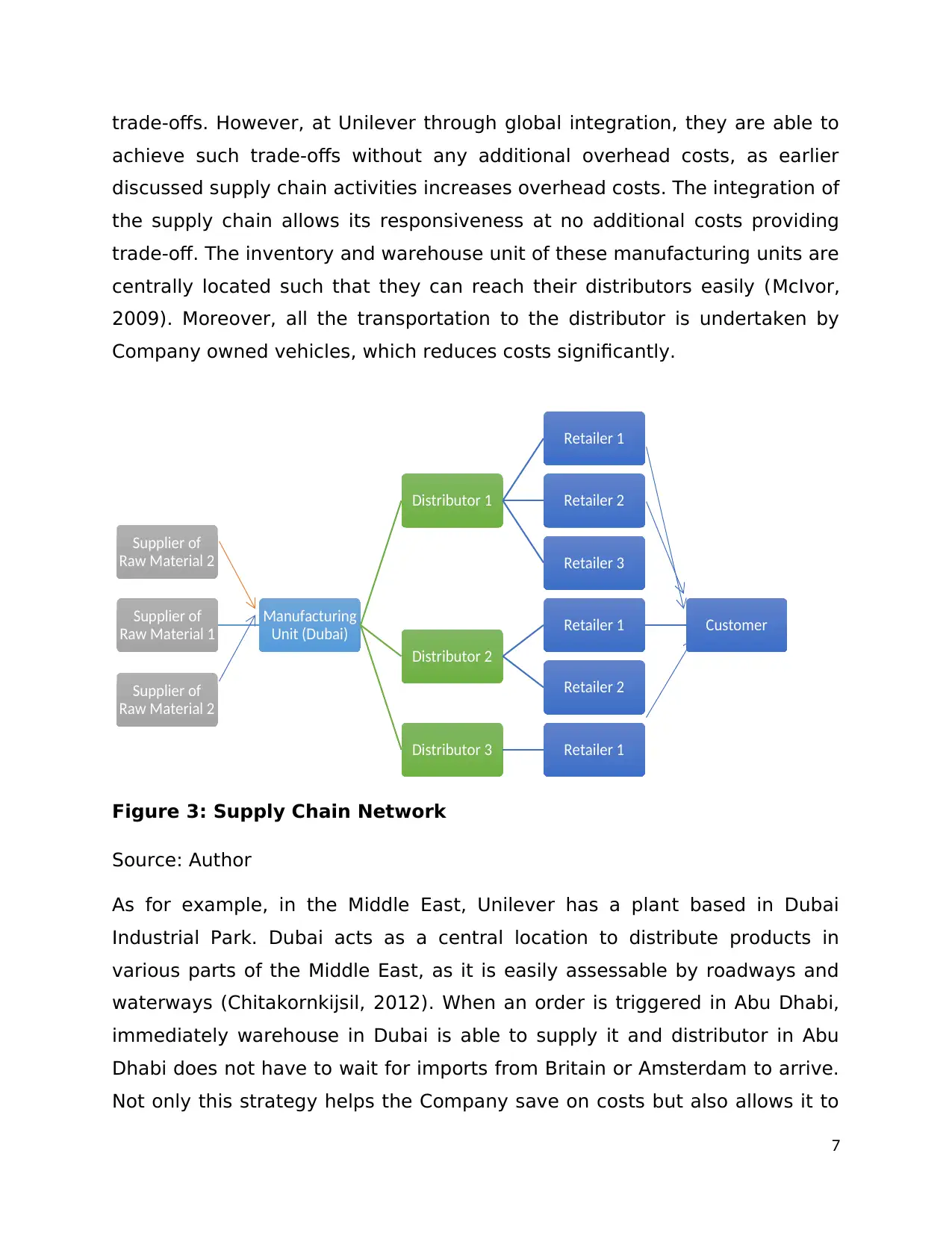
trade-offs. However, at Unilever through global integration, they are able to
achieve such trade-offs without any additional overhead costs, as earlier
discussed supply chain activities increases overhead costs. The integration of
the supply chain allows its responsiveness at no additional costs providing
trade-off. The inventory and warehouse unit of these manufacturing units are
centrally located such that they can reach their distributors easily (McIvor,
2009). Moreover, all the transportation to the distributor is undertaken by
Company owned vehicles, which reduces costs significantly.
Figure 3: Supply Chain Network
Source: Author
As for example, in the Middle East, Unilever has a plant based in Dubai
Industrial Park. Dubai acts as a central location to distribute products in
various parts of the Middle East, as it is easily assessable by roadways and
waterways (Chitakornkijsil, 2012). When an order is triggered in Abu Dhabi,
immediately warehouse in Dubai is able to supply it and distributor in Abu
Dhabi does not have to wait for imports from Britain or Amsterdam to arrive.
Not only this strategy helps the Company save on costs but also allows it to
7
Supplier of
Raw Material 1
Manufacturing
Unit (Dubai)
Distributor 1
Retailer 1
Retailer 2
Retailer 3
Distributor 2
Retailer 1 Customer
Retailer 2
Distributor 3 Retailer 1
Supplier of
Raw Material 2
Supplier of
Raw Material 2
achieve such trade-offs without any additional overhead costs, as earlier
discussed supply chain activities increases overhead costs. The integration of
the supply chain allows its responsiveness at no additional costs providing
trade-off. The inventory and warehouse unit of these manufacturing units are
centrally located such that they can reach their distributors easily (McIvor,
2009). Moreover, all the transportation to the distributor is undertaken by
Company owned vehicles, which reduces costs significantly.
Figure 3: Supply Chain Network
Source: Author
As for example, in the Middle East, Unilever has a plant based in Dubai
Industrial Park. Dubai acts as a central location to distribute products in
various parts of the Middle East, as it is easily assessable by roadways and
waterways (Chitakornkijsil, 2012). When an order is triggered in Abu Dhabi,
immediately warehouse in Dubai is able to supply it and distributor in Abu
Dhabi does not have to wait for imports from Britain or Amsterdam to arrive.
Not only this strategy helps the Company save on costs but also allows it to
7
Supplier of
Raw Material 1
Manufacturing
Unit (Dubai)
Distributor 1
Retailer 1
Retailer 2
Retailer 3
Distributor 2
Retailer 1 Customer
Retailer 2
Distributor 3 Retailer 1
Supplier of
Raw Material 2
Supplier of
Raw Material 2
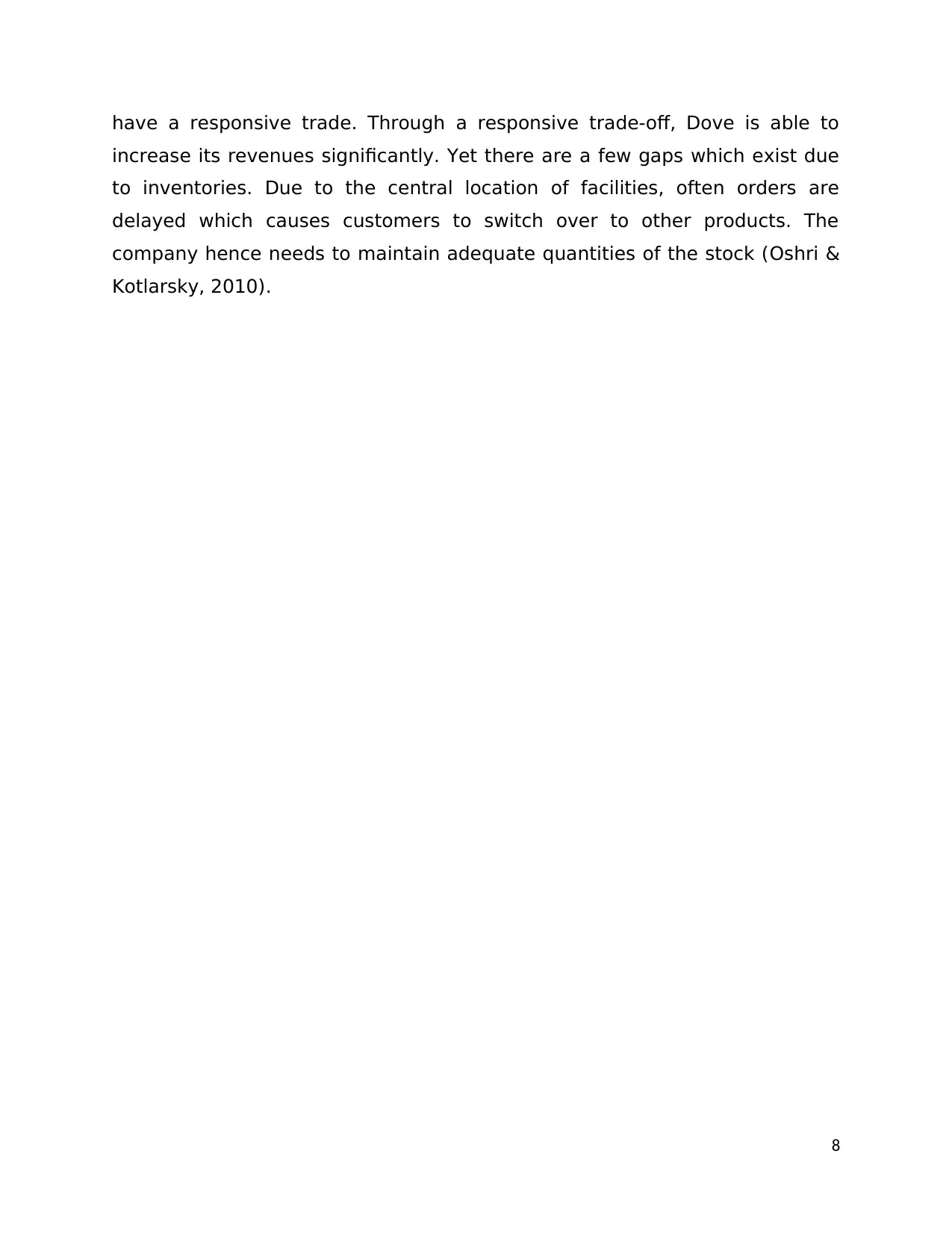
have a responsive trade. Through a responsive trade-off, Dove is able to
increase its revenues significantly. Yet there are a few gaps which exist due
to inventories. Due to the central location of facilities, often orders are
delayed which causes customers to switch over to other products. The
company hence needs to maintain adequate quantities of the stock (Oshri &
Kotlarsky, 2010).
8
increase its revenues significantly. Yet there are a few gaps which exist due
to inventories. Due to the central location of facilities, often orders are
delayed which causes customers to switch over to other products. The
company hence needs to maintain adequate quantities of the stock (Oshri &
Kotlarsky, 2010).
8
⊘ This is a preview!⊘
Do you want full access?
Subscribe today to unlock all pages.

Trusted by 1+ million students worldwide
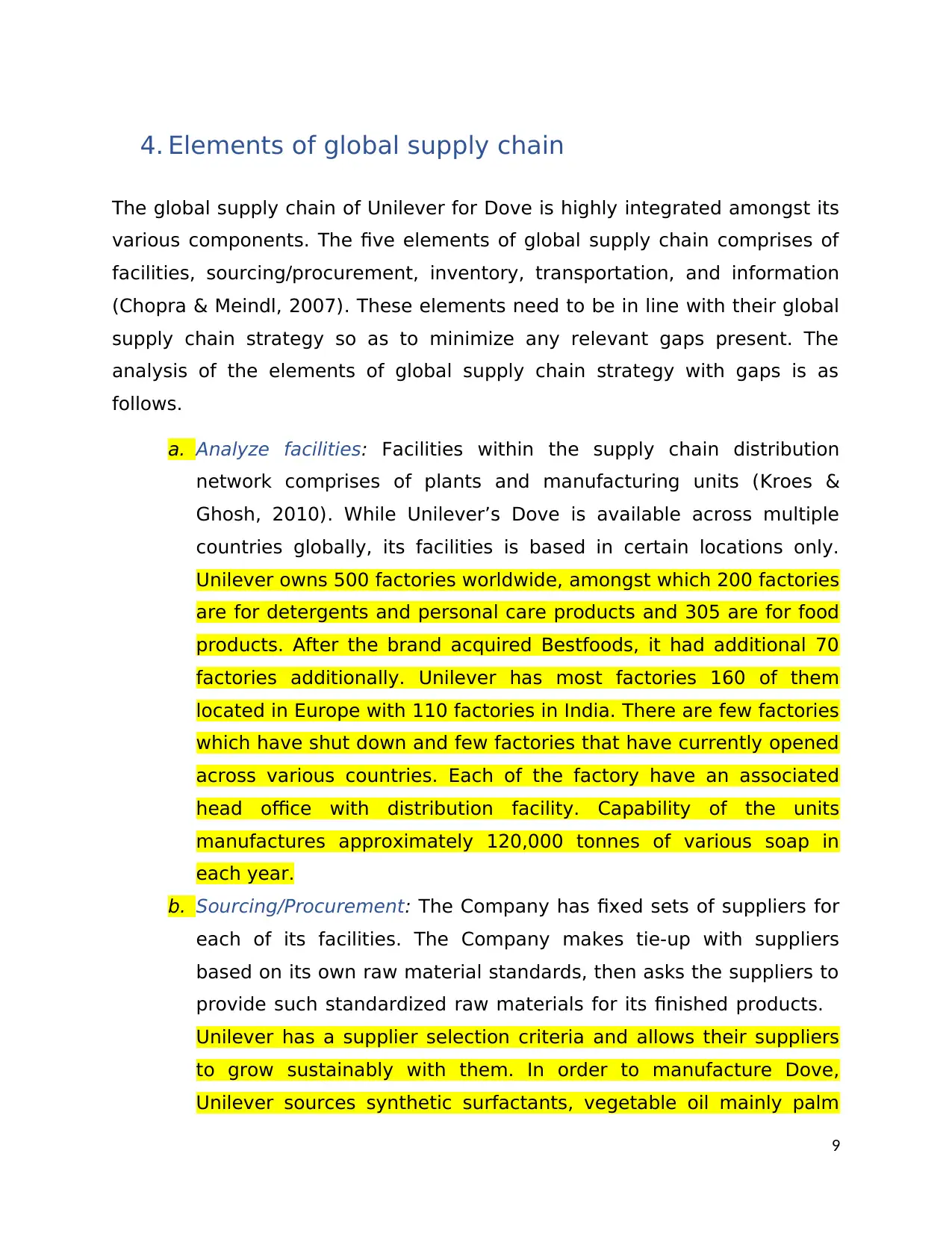
4. Elements of global supply chain
The global supply chain of Unilever for Dove is highly integrated amongst its
various components. The five elements of global supply chain comprises of
facilities, sourcing/procurement, inventory, transportation, and information
(Chopra & Meindl, 2007). These elements need to be in line with their global
supply chain strategy so as to minimize any relevant gaps present. The
analysis of the elements of global supply chain strategy with gaps is as
follows.
a. Analyze facilities: Facilities within the supply chain distribution
network comprises of plants and manufacturing units (Kroes &
Ghosh, 2010). While Unilever’s Dove is available across multiple
countries globally, its facilities is based in certain locations only.
Unilever owns 500 factories worldwide, amongst which 200 factories
are for detergents and personal care products and 305 are for food
products. After the brand acquired Bestfoods, it had additional 70
factories additionally. Unilever has most factories 160 of them
located in Europe with 110 factories in India. There are few factories
which have shut down and few factories that have currently opened
across various countries. Each of the factory have an associated
head office with distribution facility. Capability of the units
manufactures approximately 120,000 tonnes of various soap in
each year.
b. Sourcing/Procurement: The Company has fixed sets of suppliers for
each of its facilities. The Company makes tie-up with suppliers
based on its own raw material standards, then asks the suppliers to
provide such standardized raw materials for its finished products.
Unilever has a supplier selection criteria and allows their suppliers
to grow sustainably with them. In order to manufacture Dove,
Unilever sources synthetic surfactants, vegetable oil mainly palm
9
The global supply chain of Unilever for Dove is highly integrated amongst its
various components. The five elements of global supply chain comprises of
facilities, sourcing/procurement, inventory, transportation, and information
(Chopra & Meindl, 2007). These elements need to be in line with their global
supply chain strategy so as to minimize any relevant gaps present. The
analysis of the elements of global supply chain strategy with gaps is as
follows.
a. Analyze facilities: Facilities within the supply chain distribution
network comprises of plants and manufacturing units (Kroes &
Ghosh, 2010). While Unilever’s Dove is available across multiple
countries globally, its facilities is based in certain locations only.
Unilever owns 500 factories worldwide, amongst which 200 factories
are for detergents and personal care products and 305 are for food
products. After the brand acquired Bestfoods, it had additional 70
factories additionally. Unilever has most factories 160 of them
located in Europe with 110 factories in India. There are few factories
which have shut down and few factories that have currently opened
across various countries. Each of the factory have an associated
head office with distribution facility. Capability of the units
manufactures approximately 120,000 tonnes of various soap in
each year.
b. Sourcing/Procurement: The Company has fixed sets of suppliers for
each of its facilities. The Company makes tie-up with suppliers
based on its own raw material standards, then asks the suppliers to
provide such standardized raw materials for its finished products.
Unilever has a supplier selection criteria and allows their suppliers
to grow sustainably with them. In order to manufacture Dove,
Unilever sources synthetic surfactants, vegetable oil mainly palm
9
Paraphrase This Document
Need a fresh take? Get an instant paraphrase of this document with our AI Paraphraser
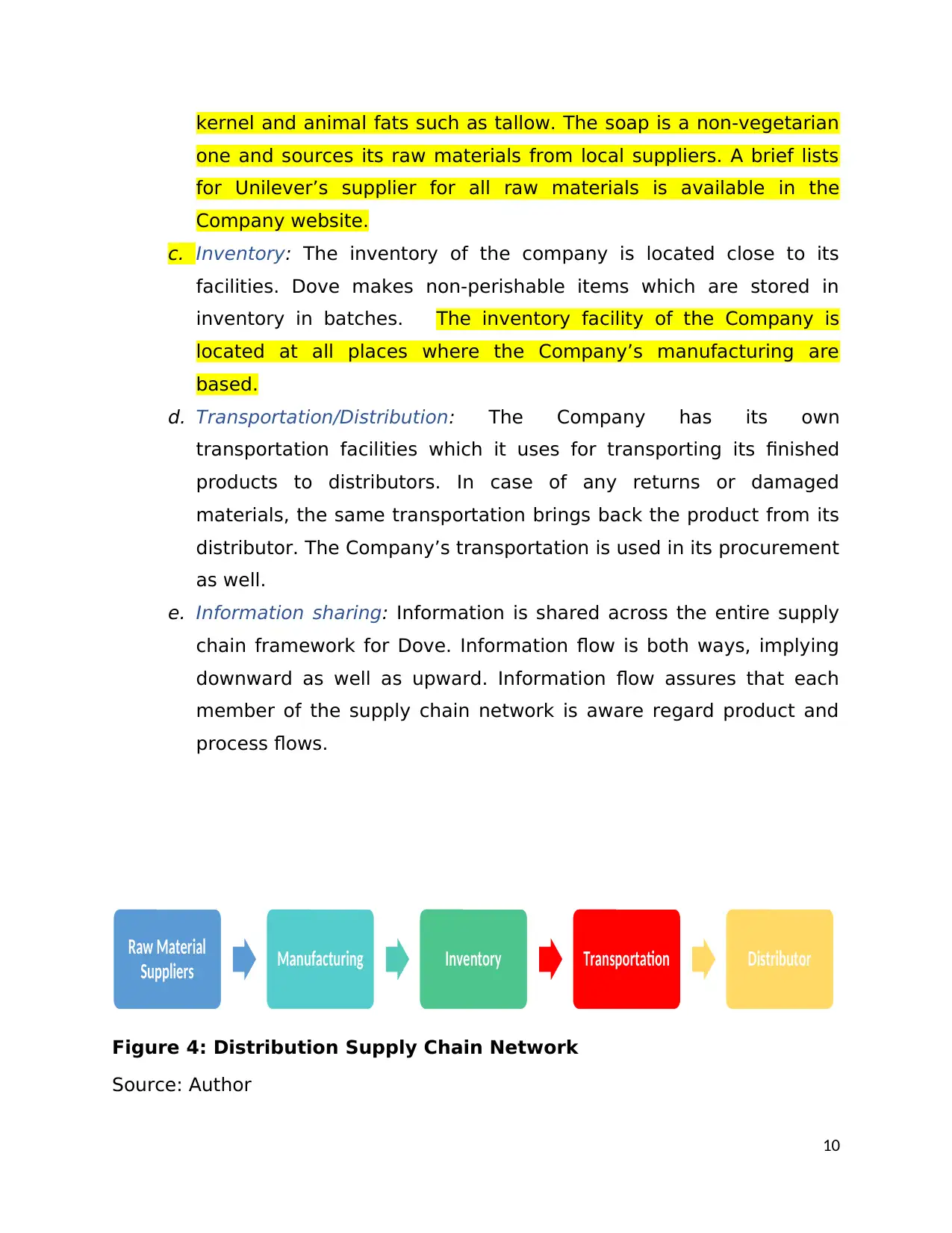
kernel and animal fats such as tallow. The soap is a non-vegetarian
one and sources its raw materials from local suppliers. A brief lists
for Unilever’s supplier for all raw materials is available in the
Company website.
c. Inventory: The inventory of the company is located close to its
facilities. Dove makes non-perishable items which are stored in
inventory in batches. The inventory facility of the Company is
located at all places where the Company’s manufacturing are
based.
d. Transportation/Distribution: The Company has its own
transportation facilities which it uses for transporting its finished
products to distributors. In case of any returns or damaged
materials, the same transportation brings back the product from its
distributor. The Company’s transportation is used in its procurement
as well.
e. Information sharing: Information is shared across the entire supply
chain framework for Dove. Information flow is both ways, implying
downward as well as upward. Information flow assures that each
member of the supply chain network is aware regard product and
process flows.
Figure 4: Distribution Supply Chain Network
Source: Author
10
Raw Material
Suppliers Manufacturing Inventory Transportation Distributor
one and sources its raw materials from local suppliers. A brief lists
for Unilever’s supplier for all raw materials is available in the
Company website.
c. Inventory: The inventory of the company is located close to its
facilities. Dove makes non-perishable items which are stored in
inventory in batches. The inventory facility of the Company is
located at all places where the Company’s manufacturing are
based.
d. Transportation/Distribution: The Company has its own
transportation facilities which it uses for transporting its finished
products to distributors. In case of any returns or damaged
materials, the same transportation brings back the product from its
distributor. The Company’s transportation is used in its procurement
as well.
e. Information sharing: Information is shared across the entire supply
chain framework for Dove. Information flow is both ways, implying
downward as well as upward. Information flow assures that each
member of the supply chain network is aware regard product and
process flows.
Figure 4: Distribution Supply Chain Network
Source: Author
10
Raw Material
Suppliers Manufacturing Inventory Transportation Distributor
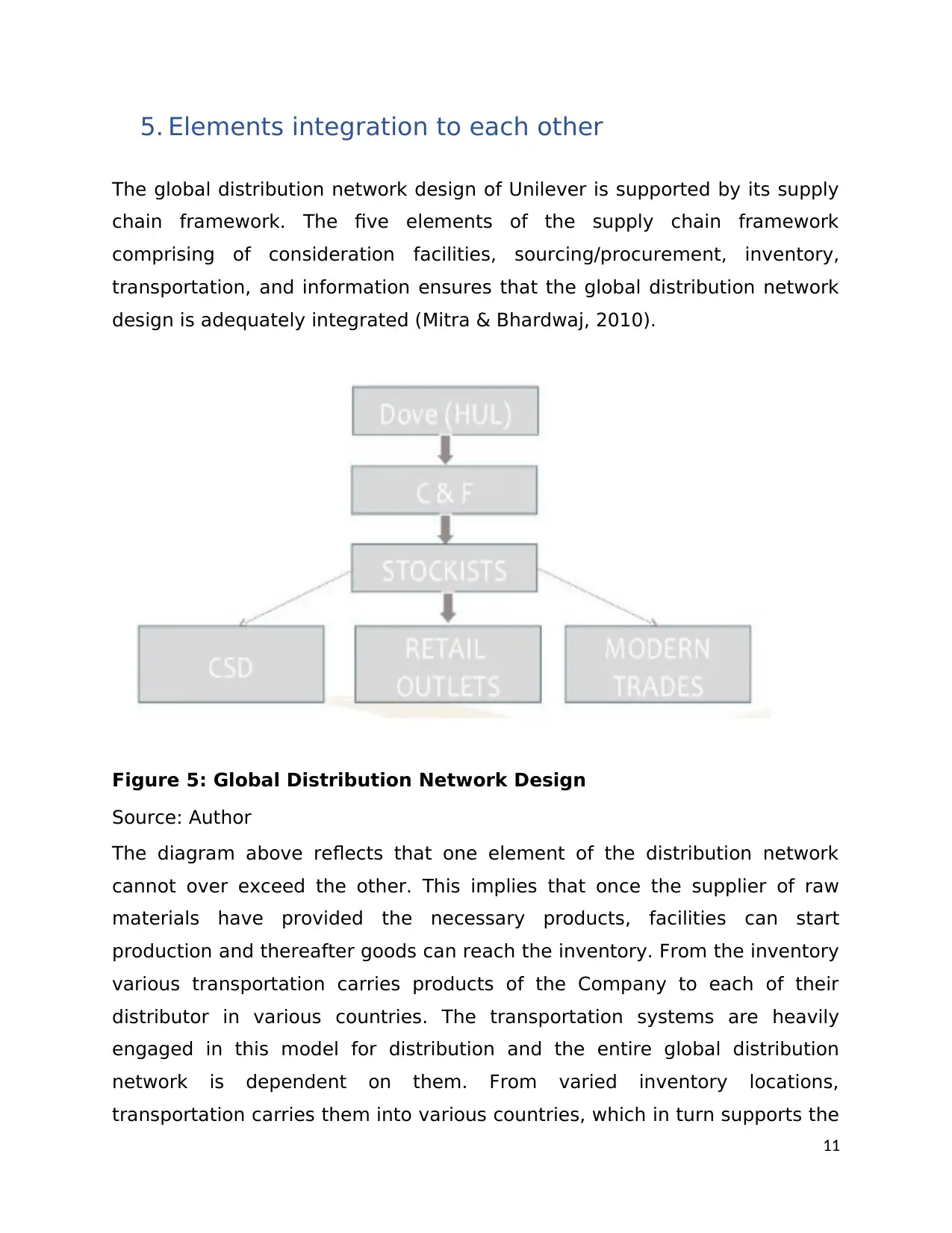
5. Elements integration to each other
The global distribution network design of Unilever is supported by its supply
chain framework. The five elements of the supply chain framework
comprising of consideration facilities, sourcing/procurement, inventory,
transportation, and information ensures that the global distribution network
design is adequately integrated (Mitra & Bhardwaj, 2010).
Figure 5: Global Distribution Network Design
Source: Author
The diagram above reflects that one element of the distribution network
cannot over exceed the other. This implies that once the supplier of raw
materials have provided the necessary products, facilities can start
production and thereafter goods can reach the inventory. From the inventory
various transportation carries products of the Company to each of their
distributor in various countries. The transportation systems are heavily
engaged in this model for distribution and the entire global distribution
network is dependent on them. From varied inventory locations,
transportation carries them into various countries, which in turn supports the
11
The global distribution network design of Unilever is supported by its supply
chain framework. The five elements of the supply chain framework
comprising of consideration facilities, sourcing/procurement, inventory,
transportation, and information ensures that the global distribution network
design is adequately integrated (Mitra & Bhardwaj, 2010).
Figure 5: Global Distribution Network Design
Source: Author
The diagram above reflects that one element of the distribution network
cannot over exceed the other. This implies that once the supplier of raw
materials have provided the necessary products, facilities can start
production and thereafter goods can reach the inventory. From the inventory
various transportation carries products of the Company to each of their
distributor in various countries. The transportation systems are heavily
engaged in this model for distribution and the entire global distribution
network is dependent on them. From varied inventory locations,
transportation carries them into various countries, which in turn supports the
11
⊘ This is a preview!⊘
Do you want full access?
Subscribe today to unlock all pages.

Trusted by 1+ million students worldwide
1 out of 20
Related Documents
Your All-in-One AI-Powered Toolkit for Academic Success.
+13062052269
info@desklib.com
Available 24*7 on WhatsApp / Email
![[object Object]](/_next/static/media/star-bottom.7253800d.svg)
Unlock your academic potential
Copyright © 2020–2026 A2Z Services. All Rights Reserved. Developed and managed by ZUCOL.





